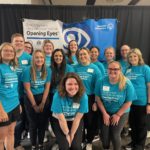
The practice team at True Vision Optometric Group. Dr. Allard says the practice’s culture of teamwork helps them better serve patients, and creates a better workplace.
By Tyson Allard, OD
June 15, 2022
The best practice improvement ideas are not always found within the optical industry. Here are a few changes we made that were inspired by experiences outside of optometry.
Our practice has grown by at least 20 percent in year-over-year revenue for at least the last eight years due in part to these improvements.
Documented Processes for Job Duties & Tasks
When I was a member of the U.S. Air Force, I discovered the usefulness of documented processes for job duties and tasks. I learned how having a set protocol for everything that needs to get done can enhance consistency and enforce quality control.
I wanted a clear, direct way for our team members to consistently accomplish all tasks associated with their jobs efficiently and effectively. For every job or task in the office we now have a preferred process for completing the work, which is documented in an office manual.
To get this done, we had every team member write down and develop a manual for their job role. Once written down by each team member, our chief operating officer reviewed and edited the processes. The cost in dollars and cents of doing this was $300 for the paper we used. On average, it took team members 3-5 hours to create manuals for their job roles. I had them work on it when I was out of the office or during slow days. I have them review the manuals once a year to make needed updates.
Every team member now knows their job and it is documented in written form, so there is no confusion about how they should approach each task assigned to them. They have documented step-by-step instructions for everything they need to get done.
The added consistency of our team’s work correlates to a greater consistency in office operations. Training happens faster and easier when there is a straight-forward protocol for each task in the office. The detailed instructions act as a job aid for new team members to refer to. That means we spend less time getting new team members up to speed and there are fewer errors in the office that adversely impact the patient experience.
Click HERE to see the documented responsibilities of the front-desk employee in our office.
Maintaining Positivity
I was a counselor at a summer camp years ago, and saw the importance of maintaining a positive feeling in a business. Children can experience sadness and anxiety when leaving their homes for four weeks to come to camp. As a counselor, no matter what day, or what mood I was in, I needed to stay positive to help the child redirect their attitude into a better one.
In a practice, it’s just as essential for the doctor and practice leader to project a positive attitude to team members and patients. Our patients and team members look to us for guidance and advice, which is hard to give in a powerful way if it is not done with a positive perspective.
Other Articles to Explore
Every morning, before reaching the office, I make a concerted effort to clear my head of stresses that may result in me projecting anything less than a positive attitude. Books can be helpful in showing you how to free your mind from stressors that impede positivity. I have spent around $100 on books and other materials over the years that instructed on me developing into a more positive person. “The Power of Habit: Why We Do What We Do in Life and Business” by Charles Duhigg is a book that has been especially helpful to me in taking a positive approach everyday.
As a result of this concerted effort to approach life and work with a positive attitude, I am able to have conversations with patients that are focused on finding solutions and making improvements to quality of life, rather than on the problems facing them. They know that our office is the place to come to for solutions that will improve their lives. We have seen tremendous growth, and I think part of that success is due to how well we are able to communicate an upbeat, positive attitude to patients.
Teamwork Culture
An accounting firm my practice uses gave me the idea to nurture more of a teamwork-oriented culture. As I watched how this accounting firm operated, I was impressed by how their people brought a teamwork culture into everything they did. Whether it was how the firm marketed itself, the printed materials it developed, its uniforms, and or the words used to communicate, all of its team members appeared to be perfectly synchronized.
The teamwork approach of this accounting firm inspired me to undergo a full logo and name change for the practice. In addition, we implemented scrub uniforms with name tags, and we now address everyone as “team members.” We market as a team that helps our patients see better and achieve what truly matters. For example, we have improved the teamwork of the hand-off from doctor to optician, with opticians now better reinforcing my messaging about needed prescriptions.
To get all this done, our COO and I sat down and reviewed the wording of our employee handbook, editing it to enforce a teamwork message, replacing all references to “employee” with team member. We also met with a marketing firm to create a new practice name and logo. We went from being known as Allard Eye Care to True Vision Optometric Group, which moved the emphasis from me to the practice as a team.
It cost us approximately $5,000 for logo design, name tags and uniforms.
It is now obvious to our patients that we are a team. We have noticed less requesting of specific staff members, and our patients have been more open to anyone helping them with needs like frame adjustments.
Our marketing is now easier because we bring a clear, direct message with it that is echoed by all of our team members. Our hiring is also easier because our culture of teamwork is a draw in our community for those looking for a place to work where they feel they will be happy.
Whatever your practice culture is, it needs to be an intentional decision, and finding ways to enforce it has to be a priority. The focus of our practice is teamwork. Once you decide what the focus of your practice is, develop a culture around it to make sure it becomes a reality.
 Tyson Allard, OD, is the owner of True Vision Optometric Group, which has three locations in Oklahoma. To contact him: tallard@truevisionoklahoma.com
Tyson Allard, OD, is the owner of True Vision Optometric Group, which has three locations in Oklahoma. To contact him: tallard@truevisionoklahoma.com





















